Hoplunnis is a genus of eels in the duckbill eel family Nettastomatidae. It currently contains the following species:
Chlopsis longidens is an eel in the family Chlopsidae. It was described by Samuel Garman in 1899, originally under the genus Atopichthys. It is known from a single leptocephalus specimen collected from between Ecuador and the Galapagos Islands, in the central eastern Pacific Ocean. From that specimen. the species is known to dwell in a tropical, marine climate at a maximum depth of 3,184 m. The specimen may possibly be a larval bicolor false moray.
The shortsnout conger, also known as the thicklip conger, is an eel in the family Congridae. It was described by Samuel Garman in 1899, originally under the genus Atopichthys. It is a tropical, marine eel which is known from the eastern central Pacific Ocean, including Colombia, Costa Rica, Ecuador, El Salvador, Guatemala, Honduras, Mexico, Nicaragua, and Panama. It leads a reclusive, benthic, burrowing lifestyle, and typically dwells at a depth range of 27–2198 metres. Males can reach a maximum total length of 30 centimetres.
Paraconger ophichthys is an eel in the family Congridae. It was described by Samuel Garman in 1899, originally under the genus Atopichthys. It is a tropical, marine eel which is known from Cocos Island, in the eastern central Pacific Ocean. It is known to dwell at a depth of 1953 metres.
The largehead conger is an eel in the family Congridae. It was described by Samuel Garman in 1899, originally under the genus Uroconger. It is a marine, deep water-dwelling eel which is known from southern Canada to Chile, in the eastern Pacific Ocean. It dwells at a depth range of 165–935 metres. Males can reach a maximum total length of 100 centimetres.
The neighbor conger is an eel in the family Congridae. It was described by Samuel Garman in 1899, originally under the genus Uroconger. It is a marine, deep water-dwelling eel that is known from the southwestern and western central Atlantic Ocean, including the Bahamas, Brazil, Cuba, and Mexico. It dwells at a depth range of 101–503 metres (331–1,650 ft). Males can reach a maximum total length of 46.2 centimetres (18.2 in).
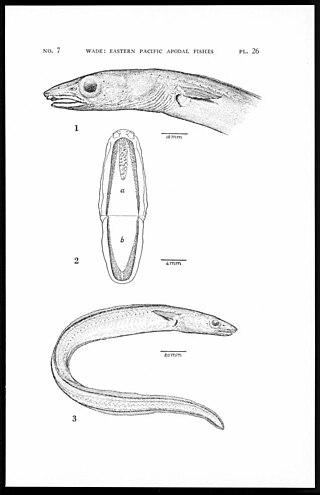
Gnathophis cinctus, the hardtail conger or Catalina conger, is an eel in the family Congridae. It was described by Samuel Garman in 1899, originally under the genus Atopichthys. It is a tropical, marine eel which is known from the eastern central and southeastern Pacific Ocean, including Chile, Colombia, Costa Rica, Ecuador, El Salvador, Guatemala, Honduras, Mexico, Nicaragua, Panama, Peru, and the United States. It dwells at a depth range of 9–336 metres, and leads a benthic lifestyle, burrowing into loose sand. Males can reach a maximum total length of 42 cm.
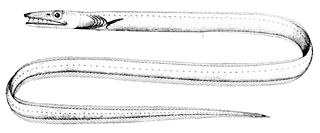
The blacktail pike-conger is an eel in the family Nettastomatidae. It was described by George Brown Goode and Tarleton Hoffman Bean in 1896. It is a subtropical, marine eel which is known from the western Atlantic Ocean. It is known to dwell at a maximum depth of 203 meters. Males can reach a maximum total length of 36.6 centimeters.
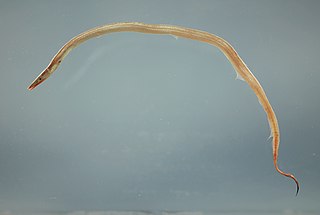
The freckled pike-conger, also known as the silver conger, is an eel in the family Nettastomatidae. It was described by Isaac Ginsburg in 1951. It is a marine, subtropical eel which is known from the western central Atlantic Ocean, including the Gulf of Mexico, Colombia, and towards the mouth of the Amazon River. It dwells at a depth range of 55–310 meters. Males can reach a maximum total length of 54.2 centimeters.
The slender duckbill eel is an eel in the family Nettastomatidae. It was described by Charles Tate Regan in 1915. It is a marine, deep water-dwelling eel which is known from the Gulf of Guinea, in the eastern Atlantic Ocean. It inhabits the continental shelf and slope. Males can reach a maximum total length of 55.5 centimetres (21.9 in).
Hoplunnis schmidti is an eel in the family Nettastomatidae. It was described by Johann Jakob Kaup in 1860. It is a marine, tropical eel which is known from Venezuela, in the western central Atlantic Ocean.
The spotted pike-conger, also known as the conger eel in Cuba, is an eel in the family Nettastomatidae. It was described by Isaac Ginsburg in 1951. It is a marine, deep water-dwelling eel which is known from the western Atlantic Ocean, including the Gulf of Mexico and the Straits of Florida, USA. It dwells at a depth range of 130 to 420 meters, and inhabits benthic sediments of mud. Males can reach a maximum total length of 46 centimeters (18 in).
Venefica ocella is an eel in the family Nettastomatidae. It was described by Samuel Garman in 1899. It is a marine, deep water-dwelling eel which is known from the eastern Pacific Ocean. It is known to dwell at a depth of 1,953 metres (6,407 ft).
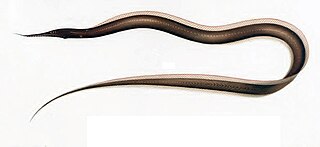
Venefica tentaculata is an eel in the family Nettastomatidae. It was described by Samuel Garman in 1899. It is a marine, subtropical eel which is known from the eastern central and northwestern Pacific Ocean, including Mexico, Nicaragua, Japan, and the United States. It dwells at a depth range of 100 to 500 metres, but may dive even deeper. Males can reach a maximum total length of 90 centimetres (35 in).
The death-banded snake eel is an eel in the family Ophichthidae. It was described by Samuel Garman in 1899. It is a tropical, marine eel which is known from the eastern central and southeastern Pacific Ocean, including the central Gulf of California, Colombia, Costa Rica, Mexico and Panama. It dwells at a depth range of 35–760 metres, and forms burrows in sandy and muddy bottoms. Males can reach a maximum total length of 86 centimetres.
The yellow snake eel is an eel in the family Ophichthidae. It was described by David Starr Jordan and Charles Henry Gilbert in 1882. It is a marine, subtropical eel known from the eastern central and southeastern Pacific Ocean, including Chile, Costa Rica, Colombia, Ecuador, Guatemala, El Salvador, Honduras, Nicaragua, Mexico, Panama, Peru, and the United States. It dwells at a depth range of 1 to 110 m, and forms burrows in rocky and sandy regions. Males can reach a maximum total length of 98 cm (39 in), but more commonly reach a length of 50 cm (20 in).
Avocettina bowersii is an eel in the family Nemichthyidae. It was described by Samuel Garman in 1899. It is a marine, deep water-dwelling eel which is known from California, U.S.A.; Peru, and Chile. It dwells at a depth range of 92–641 metres, although the type specimen was collected from a depth of 2,692 metres.

Serrivomer sector, known commonly as the sawtooth eel, the saw-tooth snipe or the deep-sea eel, is an eel in the family Serrivomeridae. It was described by Samuel Garman in 1899. It is a marine, deep water-dwelling eel which is known from the eastern and western Pacific Ocean, including Japan, Chile, and California, USA. It dwells at a depth range of 0 to 3,243 metres, most often around 305 metres (1,001 ft). Males can reach a maximum total length of 76 centimetres (30 in).
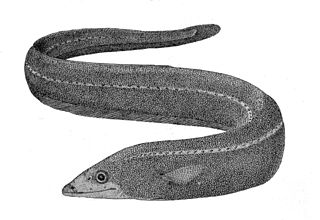
The shortdorsal cutthroat eel is an eel in the family Synaphobranchidae. It was described by Albert Günther in 1887. It is a marine, deep water-dwelling eel which is known from the Indo-Pacific and western central Atlantic Ocean, including Zanzibar, Maldives, Australia, Japan, Suriname, and the Gulf of Mexico. It dwells at a depth range of 900 to 3,000 metres, most often between 1,000 to 2,500 metres, and leads a benthic lifestyle, inhabiting the continental slope. Males can reach a maximum total length of 111 centimetres (44 in).
Leptochilichthys agassizii, or Agassiz' smooth-head, is a species of fish in the family Alepocephalidae. It is named for the scientist and engineer Alexander Agassiz (1835–1910), who commanded the 1899 survey aboard the USS Albatross on which the fish was discovered.





